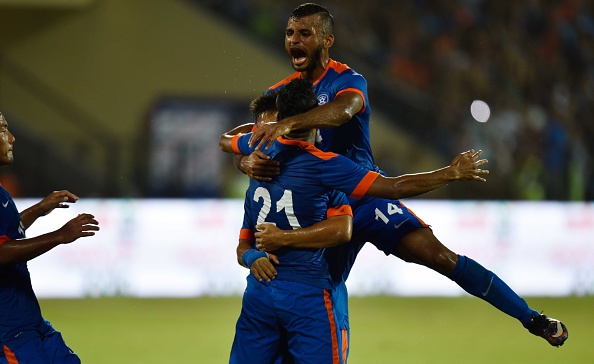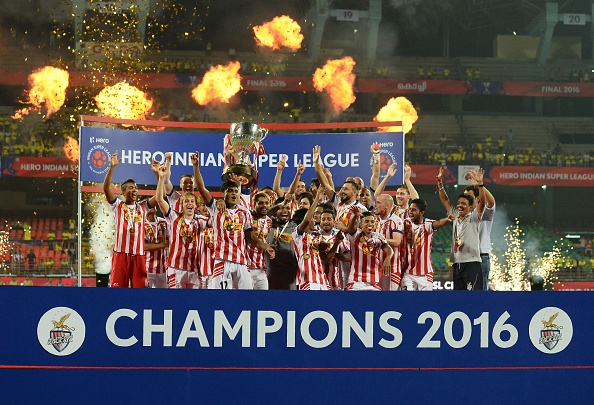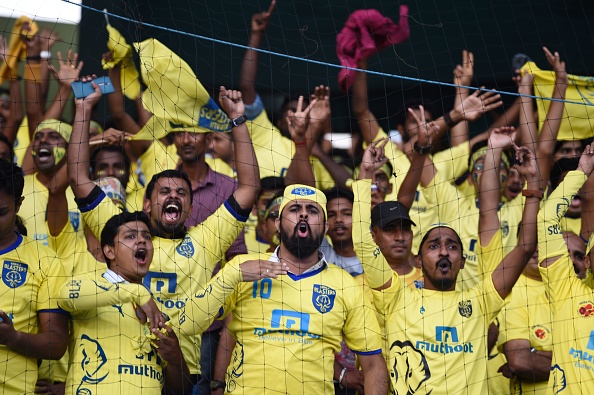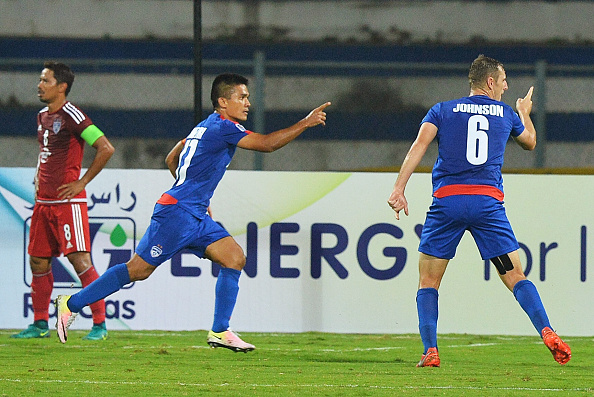
ISL and India’s goal of reaching FIFA World Cup 2022

The stadium is yellow, dipping with fans lined up many hours in advance outside the stadium to provide a prelude to an epic football encounter. The atmosphere is electric, a raucous crowd of 54,000 is going berserk in the anticipation of the action which will unfold over the next 90 minutes, leaving no stone unturned in their quest to provide a vociferous support to their home team.
The giant screen in the stadium is showing a noise level of 128 decibels. All this is a typical narrative of a European Cup final. Instead, this time the occasion is the Indian Super League (ISL) final between Kerala Blasters and Atletico de Kolkata in the Jawaharlal Nehru Stadium, Kochi.
Also Read: Blast from the Present: Kerala's resurgence into football prominence
If the fans didn’t leave anything to the imagination as far as creating a frenzied atmosphere, the teams didn’t disappoint either. Both the teams matched each other in their efforts, desire and ultimately the scoreline. The tie went to the penalty shoot-out where Atletico de Kolkata got the better of Kerala Blasters to take home their second trophy in three years.
This was also a battle of supremacy, off the field, for two former teammates turned rivals (ISL rivalry), Sachin Tendulkar, chief promoter of ISL franchise Kerala Blasters and Sourav Ganguly of Atletico de Kolkata.
ISL has certainly created a space for itself in this cricket-crazy nation and has helped put India on the world footballing map. It has proved to be an effective catalyst in popularising the sports outside its traditional stronghold and helping it to achieve a pan-India appeal. The euphoria surrounding the tournament has fizzled out a bit compared to the last two seasons but it’s still a big draw in a country that is not known in the world for its footballing exploits. It’s good to see India finally embracing ‘the beautiful game’.
ISL Impact
The league has done well as far as exposure to Indian players and coaches is concerned. There is an influx of foreign players, most past their primes, and experienced foreign coaches. This provides an opportunity to the domestic players to learn under the tutelage of some highly competitive coaches, not only the technical, but tactical aspects of the game as well.
However, its impact in improving the overall quality of Indian football is still a point that's up for debate. Only three outfield players, Shouvik Chakraborty of Delhi Dynamos, Mehtab Hossain and Sandesh Jhingan of Kerala Blasters feature among the top ten for total minutes played, with latter topping the chart at 1578 minutes of game time.
If the decrease in playing time for Indian players is a matter of concern, the performance level of Indian players is also not up to the mark. Only one player, C.K. Vineeth of Kerala Blasters, featured in the top 20 of the ISL player ratings for 2016, with no other outfield player even in the top 30.

Most of the Indian players were employed in defensive positions by foreign coaches. While it is good for the development of defenders, to see a substantial impact of ISL on the national side, it's time that more Indian players are played higher up the pitch in midfield and forward positions.
Also Read: Sportskeeda Indian Football Awards: Top 10 Indian midfielders of 2016
Some experts are also worried about the decrease in the standard of play from last season. Most coaches are play a defensive set-up, resorting to long ball tactics. This was evident in the number of goals scored which went down from 186 in the 2015 season to 145 in 2016. Ultimately it’s a game of goals and fans would love to have a score line of 4-4 than a 1-0 scoreline.
The recent withdrawal of Goan clubs, Dempo, Salgaocar and Sporting Clube de Goa from I-league doesn’t bode well for the future. If India is to emerge as a footballing powerhouse, it needs to have a strong domestic league on par with other domestic leagues of the world. It cannot expect to produce world class footballers out of a two-month long league.
With a tournament like ISL, that involves a huge amount of money, there is intense pressure on coaches to perform in a short span of time, which results in them turning to experienced foreign players, hence impacting game time for Indian players. In this context, the recent announcement by All India Football Federation (AIFF) to merge the I-league and ISL into a single league from 2017 onwards can be a very important decision for the future of Indian football.
Mission 2022 - Realistic?
Can AIFF’s goal to reach 2022 FIFA World Cup come to fruition? If yes, what role will ISL be playing in the fulfilment of that goal? It’s true that ISL has proven to be a launch pad for some of India’s brightest footballing talent. CK Vineeth, Kean Lewis, Sandesh Jhingan and Jayesh Rane have proven to be standout performers for their teams among a surfeit of foreign stars.
But all these players are currently either in their mid-twenties or at the peak of their careers and cannot be expected to carry the burden of India fan’s hopes for the 2022 World Cup.
Instead what we need is a core group of 25 under-17 players who are nurtured with a sole focus on 2022 World Cup. In that context, the under-17 FIFA World Cup couldn’t have come at a better time. The under-16 core group is currently training under the virtuous guidance of coach Nicolai Adam for the under-17 World Cup to be held in India in October.
Also Read: FIFA rankings: Argentina win Team of the Year title, while India rise two places to 135
The tournament aims to provide a much-needed impetus to India’s core development activities. This tournament provides an opportunity to develop some world class infrastructure, which in turn can be utilised to bid for FIFA U-20 World Cup and to host some international matches featuring some of the best footballing stars in the world.

India could be the next stop for European clubs during their annual summer pre-season tour to Asia and this could be an opportunity for AIFF to tap into the large urban fan base of the English Premier League.
AIFF should also make sure that the stars of the upcoming under-17 FIFA World Cup are not left high and dry after the tournament. They should be integrated into ISL clubs after the World Cup, where they get regular game time and opportunity to play with international talents. Focus on the fitness development of this core group by employing the latest techniques in sports science and medicine should be another important step in the growth of Indian football.
Football is nothing Alien to Indian Sub-continent
India is home to one of the oldest clubs in the world, Mohun Bagan AC. The club boasts a huge fan following and the rivalry between Mohun Bagan and East Bengal FC, another huge club in the I-league, can rival El-Clasico in terms of the fan following. For the record, the fixture between the two teams in 2015 attracted some 80,000 spectators.
Traditionally, the clubs in India are either sports subsidiaries of big corporate houses or run by non-profit organisations. However, the modern I-league clubs such as Bengaluru FC and Pune City FC break away from this model. They are set-up as a commercial entity modelled on the lines of clubs in European countries. The clubs have a strong grass-root development program. The clubs aim at building a strong fan base by engaging with the community at all levels of football development.
Also Read: Striker Jeje is 2016 AIFF Player of the Year
The efforts are bringing results too. After being crowned the I-league champions for the 2013-14 season, Bengaluru FC went on to become the first Indian club to reach the finals of AFC Cup 2015-16.

After ISL, a large number of clubs in India are seeing the incentive in having a professional structure. The ISL has certainly raised the visibility of Indian football and a large number of commercial brands are now willing to be associated with Indian football. This along with the latest grass-root development initiatives such as Reliance Foundation Young Champs (RFYC) program and AIFF’s recent surge in the activities for children in the age group 9-16 has set Indian football on the course of something special over the next decade.
However, the 2022 FIFA World Cup comes a little early in the sequence of events and it would be wise to make sincere efforts with an eye on the 2026 FIFA World Cup.